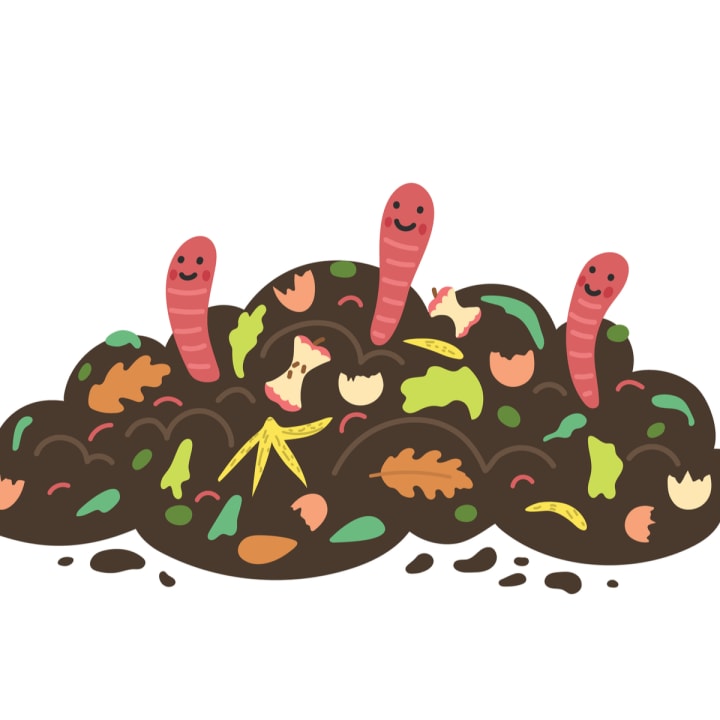
If you are reading this you probably do not need to ask yourself "why would I want to raise worms?" Just incase, let's go over some of the benefits of keeping worms, also known as vermicomposting.
- Worms turn garbage into gold, well not all garbage and not literal gold but we will get into that more later.
- Worms add beneficial microbes to soil that protect seeds as they germinate and assist the plant in maximizing health and growth.
- Profits can be made on larger scales.
- Areas with poor soil quality can benefit from worms and their casings.
- Worms can be raised virtually anywhere, even indoors.
I would also personally add that after adjusting the household habits to save certain things for the worms every day, I noticed healthier habits forming. We eat more veggies just for the scraps, we use more recyclable and compostable material as well. Our trash output has been cut down by more than half! Imagine the change this would make on a larger scale.

So where do you begin? Well, I hope to give you enough information to at least be able to begin your journey of vermicomposting without making too many mistakes. The key is to keep the worms happy, if they are satisfied with their conditions they will have no desire to leave and will be very productive. Just remember, worms like the same temps as us. If you are uncomfortable in your environment then the worms will be as well. They can withstand freezing temps and high heat for short periods of time but will most likely parish or escape. Basements work well for smaller worm operations if done properly.
Let's start with the container, as you shop online you will see so many types with prices across the board. Personally I started with the Hungry Bin, a flow through style system. These are not cheap but can be made at home if you are crafty. Otherwise for indoors or even outdoors a simple storage tub will work to start. Drill very small holes in the top and a few along the top of the sides to allow fresh air in. I do NOT drill holes in the bottom, if done properly you should not have a compost that needs to constantly drain. Worms like a moisture level of 70-80 percent and most kitchen scraps contain a lot of moisture so be careful to add water at first.

Now that your container is ready we need to get a comfy living space set up for our worms. I have tried them all, including coconut coir, dirt, paper, cardboard, and so on. What I found works the best is using something the worms can live in and also eat. This allows them to get established nicely, however it will take them longer to ramp up the breakdown of freshly added foods. So I mix a third year manure compost with shredded news paper and some live soil. The compost is fluffy, the paper is food and holds moisture and the live soil adds other bugs and microbes the mix. These are the basics, here are a few other things beneficial to add:
- Rock dust
- dried ground kelp
- Azomite
- Clay
- Sawdust
The list goes on and each item adds its own benefits to the end product. I should note as well, do not add raw, unbroken down materials to the bedding as they can generate too much heat breaking down. If using compost just make sure the compost has gone through its thermophilic phase and has cooled down.
I would fill your container about 3/4 full of this bedding mix, this will give plenty of space for a pound of worms to start (approx. 1000 worms). Do not pack it down or move your container around too much as this will make it harder for your worms to get around. Now we are ready to add some worms.

Of all the different types of worms in the world, the two most common names you will come across will be the red wiggler and the night crawler. The red wiggler is preferred when using for composting as they feed on the surface and have a better end result. Try to shop local for worms if possible, otherwise there are several very well reviewed online shippers. You should expect to pay anywhere from $30-$60 per pound or per 1,000 worms. If you see cheaper or more expensive prices, run. And some of these online retailers are family owned and operated, this means buying direct gets you great service. Just don't get caught up in all the "extras" that are unneeded.
Now your worms have arrived, you followed the instructions and they have now taken to their new home. Make sure the bedding is nice and damp, like a damp sponge that you cannot squeeze anymore water from. What I like to do is feed them on one side of the container on top of the bedding and then cover with a wet cotton shirt or paper. Everything you feed your worms changes the end product, we won't get into that science here today but I can give a general list of things worms like to eat:
- Kitchen scraps such as veggies, peels, rinds
- Coffee grounds and filters (unbleached and shredded)
- Garden waste (cut plants, bad veggies)
- Leaves (Some exceptions listed below)
- Shredded hay, grasses (too much will generate heat easily)
- Manure/animal waste (not with urine)
Here are some things to NOT feed your worms:
- Oak leaves
- Pine needles
- Dairy
- Meats/proteins
- Onions
These lists are not exclusive. When feeding, start with about an inch of food on on side of the bin and you can cover is with wet paper or a t-shirt to help keep gnats and smell down. Do not constantly check on your worms, they like darkness and solitude. I would check every couple days to start, just checking to see if they are eating. Worms prefer food that is a bit older and softer. You can also cut up food to speed up production. Remember it may also take the worms some time to come out of the nice bedding to begin feeding. If you see worms trying to escape, or balled together something is wrong. Usually either temperature or moisture level. 70-80 for both temperature and moisture are the key numbers.
As your worms eat you will begin to establish a routine and see what takes longer to break down. You will also learn what they prefer if all is going well. You may also start to see other bugs, worms, molds and fungi which are all perfectly ok and usually mean the ecosystem is healthy. Your worms, if happy and healthy, will actually begin to lay cocoons after 7 weeks or so. It will take months before you have a good ecosystem operating, and after time you will see that the worms eating habits are changing, this may mean it is time to separate some worms into a new bin and harvest some casings from your first bin!
Once your worms have settled and you think things are working it is time to keep researching. Not only that, but do your own experiments and research. I plan to write a more in depth view that doesn't cost hundreds of dollars like some of the texts I have purchased over the years. Vermicomposting can be just one more thing we can do, adding to our part in helping climate change. We can cut back on landfill waste while making new rich soil, it is a win/win.






Comments
There are no comments for this story
Be the first to respond and start the conversation.